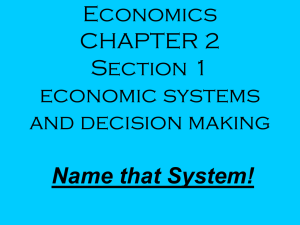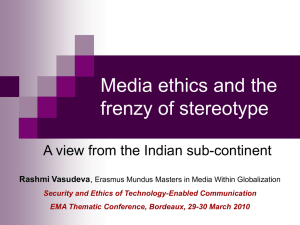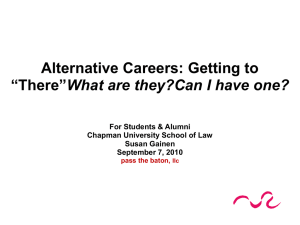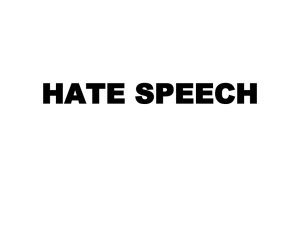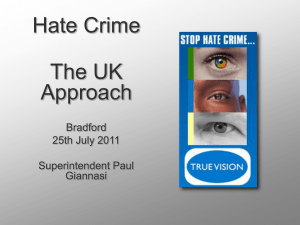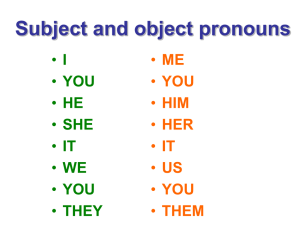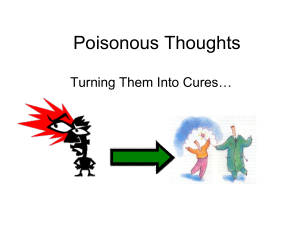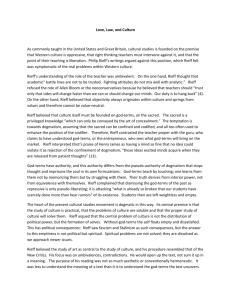hate_speech_codes_in_campuses_
advertisement
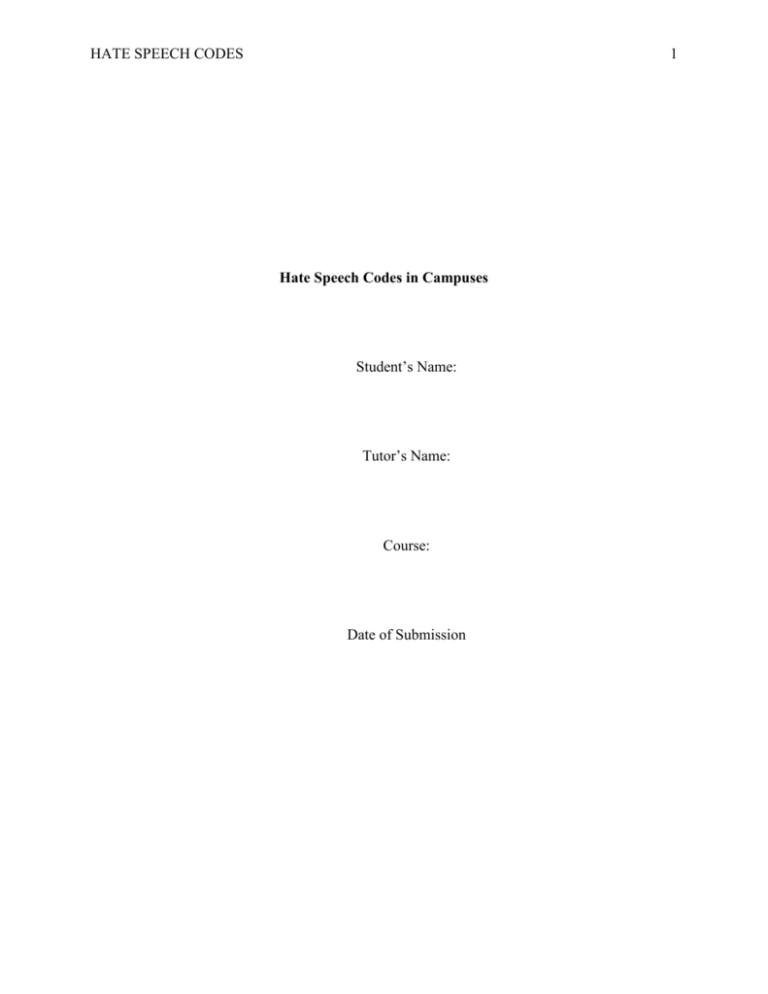
HATE SPEECH CODES 1 Hate Speech Codes in Campuses Student’s Name: Tutor’s Name: Course: Date of Submission HATE SPEECH CODES 2 Introduction During the last two decades, many colleges and universities across the country sought to reduce instances of discrimination and hate speech by enacting and implementing speech codes. While the proponents of the so-called speech codes argued that the codes were necessary to improve the learning environment of all students, opponents of speech codes saw the move as severely infringing on freedom of speech rights provided in the First Amendment of the US constitution. Regardless of the rationale provided by various colleges, it is noticeable that this period saw an unprecedented increase in the number of hate speech codes in the country. I suppose that speech codes are still necessary in the modern day colleges as they were in the last century. To illustrate this perspective, the paper will utilize articles by Hentoff and Uelmen. Besides, the paper will use an external source to articulate its arguments. Do restrictions on free speech have a place on modern college campuses? In the article titled, ‘Speech Codes on the Campus and Problems of Free Speech’, Hentoff analyzes the concept of speech codes in campus and their pros and cons. At the outset, he points out that colleges’ attempt to combat the vices of discrimination and hate speech has increased immensely during that period. Having toured in many universities and spoken with different students, Hentoff says that he finds it surprising that students across many institutions are in support of the new codes (2). In particular, Hentoff elucidates that the majority white students are in support of these combative moves (1). According to him, the enactment of these codes in various colleges are motivated by the fact that the universities are attempting to protect minority groups within the campuses. HATE SPEECH CODES 3 However, Hentoff is unenthusiastic about the effectiveness of the speech codes especially in reducing the incidences of hate speech and discrimination (1). It is apparent that speech codes within the universities tend to violate the freedom of speech. In addition, Hentoff seems unconvinced by the argument that protecting minority students from discriminatory speech in colleges increases they ability to perform at school (3). As one black student pointed out, protecting black students from discrimination and hate speech is in itself insulting to the black or even Jewish minority. The rationale is that majority of the students have grown in contexts where they are discriminated and as such, they have developed mechanisms to deal with such incidences. Hentoff also asserts that violation of freedom of speech could be in bad taste given the fact that the Fourteenth Amendment guarantees everyone equal protection of the law (2). In the article, ‘The Price of Free Speech: Campus Hate Speech Codes’, Uelmen points out that Emory University does not allow some free speech that is permissible outside the university (2). He shows the importance of combating hate speech within universities in lieu of the fact that the incidences of hate speech are on the rise. In particular, he argues that incidences of hate speech had increased tremendously between 1985 and 1990. Indeed, the article shows that there was a 400 percent increase in the number of incidences of harassment (Uelmen 1). Moreover, over 80 percent of these incidences were unreported. In other words, Uelmen is convinced that there is an apparent need to institute hate speech codes in all institutions of learning to enhance the process (2). Nonetheless, Uelmen is not oblivious of the dangers that hate speech codes could present for the universities and colleges at large (2). He highlights the fact that protecting minority groups from such incidences could negatively affect the ability of the students to tolerate diversity and cope with some dissenting opinions outside the University’s environment. HATE SPEECH CODES 4 In the modern day colleges and universities, it is imperative to take cognizance of the fact that hate speech codes protect individuals in a more important way than the freedoms the strip from the students. In other words, if harassment and hate speech targets minority groups, it is likely to cause more harm than hurt the feelings of the victims (Grey 98). This implies that hate speech represents a historical oppression of the minority (Rieff, 121). This may impede the ability of the minority student to compete fairly in academics and other aspects of education. To this end, it important to implement hate speech codes in order to give all students an equal platform to access and acquire an education. Moreover, hate speech codes have potential benefits for colleges and universities across the country. The reason is that colleges and universities provide students with an arena where they can articulate their opinions and debates in a rational way (Rieff 126). In fact, the main aim of education and learning to help the students to derive rational arguments when defending the points of view (Grey 87). To the contrary, hate speech that many codes try to minimize is neither rational nor does it increase the students’ ability to learn. As such, hate speech codes are important since they tend to reduce instances where students do not support their opinions and perspectives through reasoning and presentation of facts. In contemporary world, it is unanimous that we might sometimes restrict some freedoms for the best interest of the larger majority of citizens (Rieff 129). This specifically so when the freedom contradicts with the primary objective of an event. For instance, an owner of a theater reserves the right to remove a person who shouts and heckles in a theater. The rationale is that the behavior of the shouter contravenes the primary objective of a theatrical play that is to entertain an audience (Grey 91). It is therefore important to recognize that the primary objectives of colleges and universities is to inculcate knowledge and educate students. As such, hate speech HATE SPEECH CODES 5 in the context of academic institutions represents and obstruction from the major goal of the same. Implementing hate speech codes in colleges therefore serves as a way of achieving the goals of the institution. This has not changed in the modern day institutions since the major objectives of academic institutions remain as aforementioned (Rieff 122). To that end, hate speech codes are as important as students themselves in the context of education institutions. Conclusion In essence, hate speech codes rose to an unsurpassed way during late 1980s and early 1990s. While proponents of the codes articulate that the codes are aimed at protecting socially marginalized groups within the context of learning, opponents faulted the move as misinformed owing to the fact that they restricted freedom of speech. Both Hentoff and Uelmen analyze the issues and present their perspectives on the issues. In the modern day universities and colleges, it is important to implement hate speech codes in order to give minority students an equal arena to compete academically with other students. Besides, they help the students to be able to support their opinions in a rational way in addition to enabling academic institutions to achieve their primary goals and purposes. HATE SPEECH CODES 6 Works Cited Grey, Thomas. “Civil Rights vs. Civil Liberties: The Case of Discriminatory Harassment”, Social Philosophy & Policy, 8.1 (1990): 81-107. Hentoff, Nat. “Free Speech on the Campus”, 1991. Available at: https://www.scu.edu/ethics/publications/iie/v5n2/codes.html Retrieved: May 3, 2014 Rieff, David. “The Case against Sensitivity”. Esquire, 1.14 (1990): 120-131. Uelmen, Gerald. ‘The Price of Free Speech: Campus Hate Speech Codes’, 1990 Available at: https://www.scu.edu/ethics/publications/iie/v5n2/codes.html Retrieved: May 3, 2014

